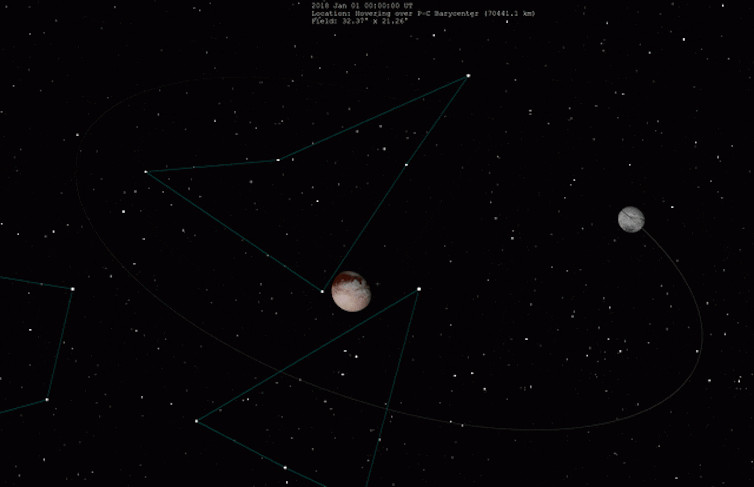NASA discovered carbon dioxide on the surface of Pluto’s moon Charon
- October 2, 2024
- 0
At the outer limits of our solar system, 5.7 billion kilometers from the Sun, lies the dwarf planet Pluto. Smaller than Australia, it is an icy world of
At the outer limits of our solar system, 5.7 billion kilometers from the Sun, lies the dwarf planet Pluto. Smaller than Australia, it is an icy world of

At the outer limits of our solar system, 5.7 billion kilometers from the Sun, lies the dwarf planet Pluto. Smaller than Australia, it is an icy world of mountains, glaciers and craters with an average temperature of -232°C. There are five moons orbiting Pluto: Styx, Nyx, Kerberos, Hydra and Charon. Charon is the largest of these. Unlike most other planetary systems, it exists in a “twin system” with its parent body; This means that they both revolve around a point in the space between them.
Pluto and its moons are still surrounded by many mysteries. However, in a new study published today Nature CommunicationA team led by astronomer Sylvia Protopapa from the Southwest Research Institute in the United States announced that they found carbon dioxide and hydrogen peroxide on the surface of Charon.
The findings, based on data from NASA’s James Webb Space Telescope, offer vital clues about how our favorite planetary/extraplanetary system formed.
Scientists first discovered Charon in 1978 while studying the orbit of Pluto. Charon is like Pluto’s younger twin. It has a width of just over 1,200 kilometers – about half the size of Pluto, making it the largest known moon in our solar system relative to its main body.
Pluto itself is already small compared to our Moon; Pluto is about two-thirds the size and one-sixth the mass of Earth’s moon. Charon’s mass is about one-eighth that of Pluto.
Charon and Pluto have an unusual orbit. While Charon orbits Pluto, Pluto orbits the central point. They behave almost like double dwarf planets. It’s not like the Moon and the Earth, where the Moon revolves around us and we don’t actually change our position.
This is one of the reasons why Pluto is no longer considered a planet and is called a dwarf planet. Its orbit with Charon means that Pluto has not cleared its orbit or become a gravitational boss. This is the criterion for Pluto to fail the planet checklist.

In 2015, NASA’s New Horizons became the first spacecraft to closely explore Pluto and its moons after a nine-year journey from Earth. This showed that Charon was composed of various chemicals.
A very cold month, rich in water ice. But it also contains ammonia and a wide variety of carbon compounds. Charon is also believed to have cryovolcanoes, which spew ice instead of magma like volcanoes on Earth.
Charon’s composition differs from Pluto and other objects beyond Neptune, where it is dominated by nitrogen and methane ice. The new detection of carbon dioxide and hydrogen peroxide in Charon could provide valuable information about how different processes interact on these trans-Neptunian objects.
Carbon dioxide is always an important molecule to understand; It tells us a lot about the history of an object. In the case of Charon, carbon dioxide is thought to have come from beneath the icy surface and entered via asteroids and other objects hitting the moon, creating craters that exposed new surface.
Scientists were able to detect carbon dioxide on Charon thanks to observations made with the revolutionary James Webb Space Telescope. This space telescope, which will be launched in 2021, has a large mirror six and a half meters wide, making it very powerful and sensitive.
It can “see” colors of infrared light that our eyes and most telescopes on Earth cannot detect. Infrared radiation is an important type of light for finding various molecules found in other objects, from planets to stars to galaxies and more.
To find these compounds, the telescope uses a technique called spectroscopy. Just as white light becomes a rainbow, the colors of light are divided into separate colors. Each element or molecule has its own color signature, like a fingerprint. These new observations of Charon showed signs of carbon dioxide and hydrogen peroxide, as well as other previously known water ice.
Charon’s formation is a scientific mystery. One of the prominent theories is that it formed like our Moon. According to this theory, approximately 4.5 billion years ago, in the Kuiper belt, where Pluto and Charon live, a large object collided with Pluto and broke off part of it, forming Charon.
It’s also possible that Pluto and Charon were two objects that collided and then became trapped in each other’s orbit.
Understanding Charon’s composition helps us better understand how it was formed. In this sense, the discovery of carbon dioxide and hydrogen peroxide is an important step forward. More importantly, it could provide clues not only about Charon but also about other objects near Pluto. A better understanding of Charon will help us understand this distant part of our solar system and the strange worlds that reside there.
Source: Port Altele
As an experienced journalist and author, Mary has been reporting on the latest news and trends for over 5 years. With a passion for uncovering the stories behind the headlines, Mary has earned a reputation as a trusted voice in the world of journalism. Her writing style is insightful, engaging and thought-provoking, as she takes a deep dive into the most pressing issues of our time.